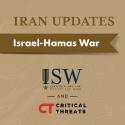Iran Update, March 14, 2024
Mar 14, 2024 - ISW Press
Hamas reportedly killed the head of a local clan in Gaza City on March 13 likely as part of Hamas’ effort to reassert its authority in the northern Gaza Strip. Hamas targeted the head and other members of the armed Dughmush clan amid local accusations that the clan stole humanitarian aid and cooperated with Israel. The clan responded to the killing by vowing to retaliate and declaring Hamas members and positions as “legitimate target[s].”[3] Hamas denied reports that its forces killed the clan members.










